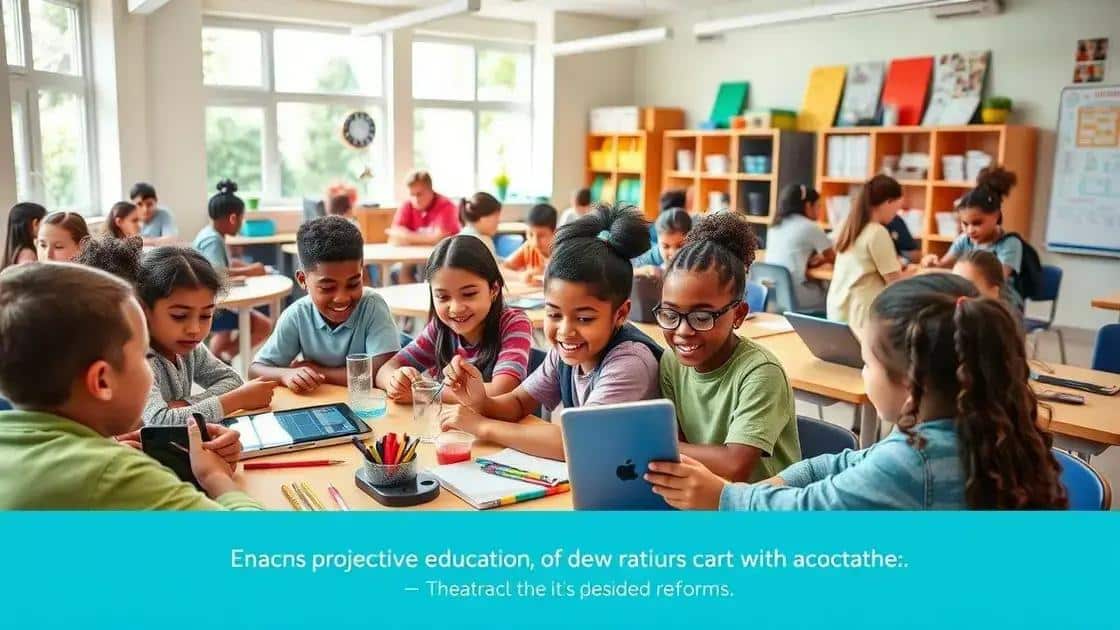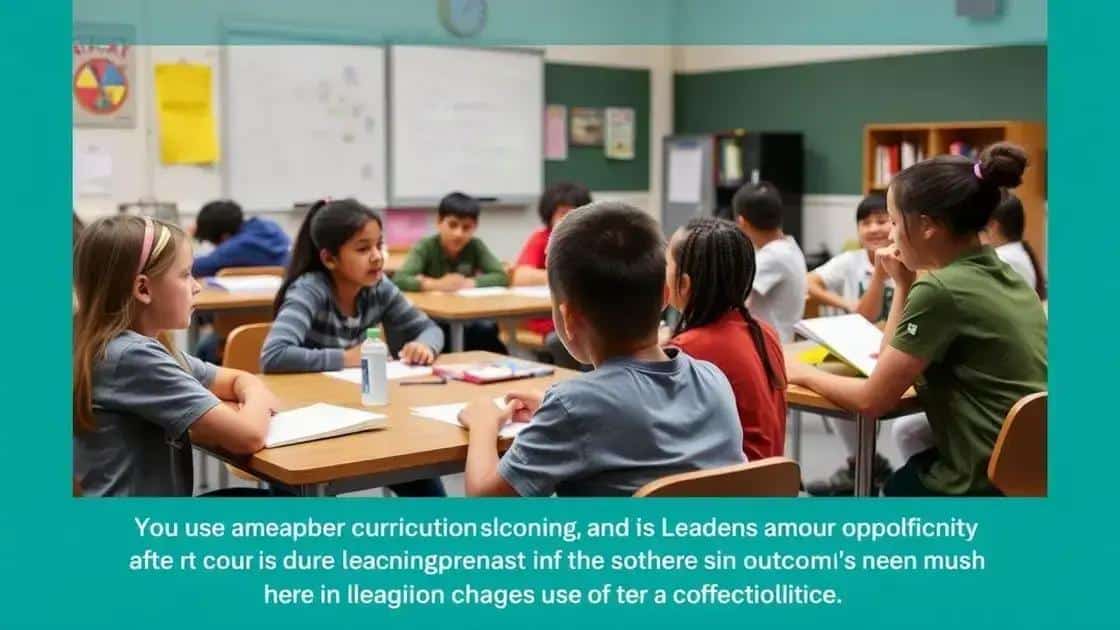Curriculum reforms: how they can transform education

Curriculum reforms focus on integrating technology, personalizing learning, and emphasizing essential skills to prepare students for a diverse and evolving world.
Curriculum reforms are crucial in shaping the landscape of education as we know it today. With the evolving demands of society, how can these changes enhance the learning experience for students? Let’s dive deeper into the significance of these reforms.
Understanding curriculum reforms
Understanding curriculum reforms is vital for grasping how education adapts to the needs of a changing world. These reforms aim to provide students with the skills necessary for their future, emphasizing critical thinking and problem-solving.
When schools implement curriculum reforms, they often focus on several key areas. This includes updating resources, incorporating technology, and aligning with educational standards. These changes help ensure that students are prepared for real-world challenges.
Key Components of Curriculum Reforms
There are important features that often shape effective curriculum reforms. Understanding these components can enhance educational practices:
- Integration of technology to support learning.
- Focus on hands-on learning experiences.
- Collaboration among educators to share best practices.
As educators embrace these changes, they encounter both opportunities and challenges. For instance, adapting teaching methods can be difficult but is essential to engage students. Supporting teachers through professional development ensures that they feel confident in delivering new content.
The Role of Stakeholders
Successful curriculum reforms also depend on contributions from various stakeholders. This includes:
- Teachers who bring practical insights.
- Administrators who facilitate necessary resources.
- Parents who support students at home.
Collaboration with the community is vital as well. When schools engage with local businesses and organizations, they can create relevant learning experiences related to career readiness.
Ultimately, understanding curriculum reforms involves recognizing their dynamic nature. These reforms are not merely changes in textbooks but a shift in how education prepares students for their futures.
The impact of curriculum changes on student outcomes

The impact of curriculum changes on student outcomes is significant and far-reaching. As schools implement new educational strategies, students often experience a more engaging and relevant learning environment. This leads to improved academic performance and a deeper understanding of subjects.
Effective curriculum reforms can enhance critical thinking and creativity. By integrating real-world applications, students learn to apply their knowledge, making learning meaningful. Teachers play a key role by adapting their instructional methods to suit the new curriculum, resulting in positive changes.
Measuring Student Success
To understand how curriculum changes influence students, educators utilize various measurement tools:
- Standardized tests to assess academic growth.
- Feedback from students on their engagement and understanding.
- Observations in the classroom to evaluate participation.
These tools help track the effectiveness of new teaching methods and identify areas for improvement. As schools shift their focus, it’s common to notice a rise in student motivation, attendance, and overall achievement.
Long-Term Benefits
Over time, students who thrive under a revised curriculum develop skills that prepare them for success beyond school. They become more adaptable, better problem solvers, and are often more equipped to navigate the complexities of modern life. These long-term advantages not only benefit the individuals but also contribute to a well-educated workforce.
In summary, the impact of curriculum changes on student outcomes is profound. By continually evaluating and refining educational practices, schools can ensure they meet the needs of all learners. This ongoing commitment to improvement ultimately fosters a generation of capable, confident individuals ready to face future challenges.
Key challenges in implementing curriculum reforms
Implementing curriculum reforms presents several key challenges that educators and institutions must navigate. These obstacles can impact the effectiveness of changes and the overall success of educational improvement efforts. Understanding these hurdles is critical for developing strategies that lead to positive outcomes.
One primary challenge is obtaining buy-in from all stakeholders, including teachers, administrators, and parents. When individuals are resistant to change, it can slow down the implementation process. Clear communication about the benefits of reforms can help to alleviate some concerns.
Training and Support for Educators
Another significant obstacle involves the need for proper training and support for teachers. Professional development is essential to equip educators with the skills necessary to effectively teach a revised curriculum. Without sufficient training, teachers may struggle to adapt their methods, which can hinder student learning.
- Providing ongoing professional development workshops.
- Creating mentoring programs pairing experienced teachers with novices.
- Facilitating collaborative planning time for educators.
Additionally, resource allocation poses a challenge. Schools often face budget constraints that limit their ability to acquire new materials and technologies needed for effective implementation. Schools must prioritize funding for essential resources to successfully implement changes.
Measurement and Evaluation
Finally, measuring the effectiveness of curriculum reforms can be tricky. Schools need to establish clear metrics to assess whether changes are yielding the desired results. Tracking student progress through data collection can help identify areas needing improvement and inform future adjustments.
By recognizing these key challenges in implementing curriculum reforms, educators can devise strategies to overcome them. Increased collaboration, training, and resource management can help make the transition smoother and more successful.
Future trends in curriculum development

Future trends in curriculum development are evolving rapidly as education systems adapt to meet the needs of a changing world. Technology integration, personalized learning, and an emphasis on essential skills are at the forefront of these developments.
One major trend is the incorporation of technology into the classroom. Schools are increasingly leveraging digital tools to enhance learning experiences. This includes using online resources, interactive applications, and learning management systems. These technologies promote collaboration and engagement among students.
Personalized Learning Approaches
An essential component of future curricula will be personalized learning. This approach tailors education to meet individual student needs, allowing for different learning paces and styles. By focusing on the unique strengths and interests of each learner, schools can foster a more meaningful educational experience.
- Adaptive learning software that adjusts content based on student performance.
- Flexible curriculum pathways that allow students to explore topics of interest.
- Increased use of formative assessments to guide instruction.
Additionally, the push for skills-based learning is gaining momentum. Educators recognize that students need more than just academic knowledge. Skills such as critical thinking, problem-solving, and collaboration are essential for success in the workforce. Future curricula will likely include more project-based learning and real-world applications.
Global Awareness and Cultural Competence
Another trend involves global awareness and cultural competence. As classrooms become more diverse, curricula must reflect this reality. Incorporating multicultural perspectives helps students appreciate different viewpoints and prepares them for a global society. Schools aim to create inclusive environments that value all cultures.
In conclusion, future trends in curriculum development promise to make education more relevant and effective for all learners. By embracing technology, personalizing learning, fostering essential skills, and promoting cultural competence, educators can help students thrive in an ever-changing world.
In summary, the future of curriculum development is bright and full of possibilities. As we embrace technology, personalized learning, and essential skills, we prepare our students for a diverse and ever-changing world. By fostering global awareness and cultural competence, we create inclusive classrooms that celebrate different perspectives. These trends reflect a commitment to making education relevant and effective, ensuring that every student has the opportunity to thrive.
FAQ – Questions about Future Trends in Curriculum Development
What is personalized learning?
Personalized learning tailors education to meet each student’s individual needs, allowing for different paces and styles of learning.
How does technology enhance curriculum development?
Technology integration provides interactive tools that engage students and facilitate collaboration, making learning more accessible and effective.
Why is focusing on essential skills important?
Focusing on essential skills prepares students for real-world challenges by developing their critical thinking, problem-solving, and collaboration abilities.
What role does cultural competence play in education?
Cultural competence helps students appreciate diverse perspectives, promoting inclusivity and preparing them for a globalized society.






